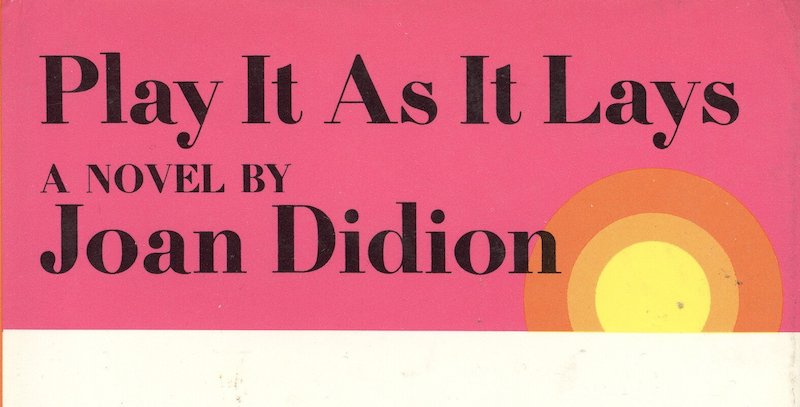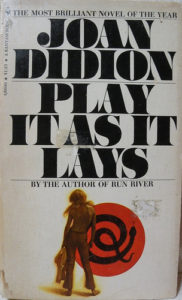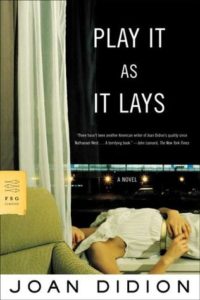

“I am what I am. To look for ‘reasons’ is beside the point”
*
“There hasn’t been another American writer of Joan Didion’s quality since Nathanael West. She writes with a razor, carving her characters out of her perceptions with strokes so swift and economical that each scene ends almost before the reader is aware of it; and yet the characters go on bleeding afterward. A pool of blood forms in the mind. Meditating on it, you are both frightened and astonished. When was the wound in flicted? How long have we to live? Miss Didion’s new novel combines this surgical prose with a crushing fatalism (the title refers to a crap game) that obliges her people end essly to circle themselves, reducing their radiuses of possibilities seeking an exit from the ‘I’—and sets it all in the cities of the desert (Los Angeles, Las Vegas). While the result is not exactly pleasant, it seems to me just about perfect according to its own austere terms.
Maria Wyeth is an internal refugee. She was born in Nevada to parents who were always waiting for the next roll of the dice, and always losing. She went to New York, because a model, survived a disastrous affair with one man and disastrously married another (Carter Lang, demon film maker). We pick up Maria after she has starred in two of Carter’s movies, given birth to a little girl with an ‘aberrant chemical in her brain,’ aborted a second child, divorced, and retired in her 30’s to Southern California with a terminal fatigue of the body and the spirit. The only game she has the energy to play is for her daughter, whom she wishes to rescue from mental home.

“Inside and outside Maria, there is only desolation. Carter, the homosexual BZ, BZ’s bitchy wife, Helene, and all the other characters seem perfect children of the desert, plastic toys with spring mechanisms inside them, wound up and sent out to whir and spin, dangerous in their very motion. The emotional terrain (brain damage, abortion, homosexuality, suicide, moral exhaustion) is a mirror?image of the landscape (rattlesnakes, freeways, gam bling casinos, motorcycle gangs, drive?in churches). One feels that, just as the characters consume themselves in circles and games, so the desert will swallow the ersatz cities on its surface, leaving every thing to the lizards and the snakes.
What makes the world of this novel, a world in which the only reply to the question ‘Why?’ is ‘Why not?’, so heartbreaking and inescapable is Miss Didion’s selection of details. There is nothing superfluous, not a word, not an incident. Personalities are more than sufficiently evoked in a single phrase—’Felicia always spoke on the telephone as if a spurious urgency could mask her radical lack of interest in talking to anyone’—and whole chapters are condensed into a single page. Such an economy testifies to a vision as bleak and as precise as Eliot’s in ‘The Wasteland.’ And if Randall Jarrell was right in saying that Eliot would have written ‘The Wasteland’ about the Garden of Eden, it is likely that Miss Didion would have written Play It as It Lays about Versailles.

“For it is the condition of a woman’s mind that is her subject; it is the ‘nothing ness’ after one has been used as an object that she explores; it is the facts beyond ‘answers’ or ‘explanations’ that she plays with … Cheerless, then. And there will undoubtedly be readers who ask: why doesn’t this girl get her head together? Join her local Women’s Liberation chapter or the Peace Corps? Go to Esalen? Read Marx? Find God? If we conceive of the novel as a kind of Drano for dissolving the sludge in the clogged plumbing of fictional characters, then certainly Miss Didion should have come up with a tidy solution. But so long as novels are permitted to be about visions, to explore situations, to see truths beyond individual manipulation, then Miss Didion need not equip Maria with a Roto Rooter or a dose of ideological uplift. The courage to say ‘Why not?’ to Nothingness is more than enough. Faulkner and Mauriac were fatalists, too. So was Freud, who had the courage of his pessimism, before the epigones co?opted him for Disneyland.
Because Miss Didion is not the sort of writer who goes in for tricks on the reader, I doubt whether ‘Wyeth’ is an intentional play on names. Yet one can’t help thinking of Andrew Wyeth’s painting ‘Christina’s World.’ Maria looks up at the house on the hill. Only the house is burning. Perhaps she will get up, and run to save her daughter. But it is her mind burning, as well; and it’s only a picture; and ultimately the world belongs to the rattle snakes. Nothing applies. A terrifying book.”
–John Leonard, The New York Times, July 21, 1970

